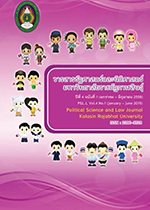การปฏิวัติการคมนาคมกับการรวมศูนย์อำนาจของรัฐในสยาม พ.ศ. 2435-2475
DOI:
https://doi.org/10.14456/gjl.2015.10คำสำคัญ:
การคมนาคม, การรวมศูนย์อำนาจ, ความเร็ว, ทางรถไฟ, โทรเลข, Transportation, Centralization, Speed, Railways, Telegraphบทคัดย่อ
การวิจัยฉบับนี้มีจุดประสงค์เพื่อศึกษาการปฏิวัติคมนาคมกับการรวมศูนย์อำนาจของรัฐในสยามระหว่าง พ.ศ.2435-2475 ผลการศึกษาพบว่า การรวมศูนย์อำนาจอย่างมีประสิทธิภาพเป็นเพราะรัฐตระหนักถึงความสำคัญของความเร็ว โดยเริ่มจากแยกการสื่อสารออกจากการคมนาคม และเชื่อมต่อกรุงเทพฯกับส่วนภูมิภาคด้วยทางรถไฟ ความเร็วของรถไฟกลายต้นทุนทางการเมืองของรัฐบาลและทำให้ต้นทุนการขนส่งระหว่างกรุงเทพฯกับพื้นที่ห่างไกลต่ำลง ผลจากการรวมศูนย์อำนาจของรัฐได้ทำให้กรุงเทพฯกลายเป็นศูนย์กลางการคมนาคมสมัยใหม่ด้วยเช่นกันThe purpose of this research is to study the transportation revolution and the centralization of the state in Siam 1892-1932. The result has shown that the state can centralize the power efficiently because of it can enhance the importance of speed by separating communication from the transport and connect Bangkok to other regions by rail. The speed of the train became a political capital for the government and the cost of transportation between Bangkok and the remote areas was greatly reduced. As a result of the centralization of the state, Bangkok has become a modern transportation hub as well.
Downloads
ดาวน์โหลด
เผยแพร่แล้ว
รูปแบบการอ้างอิง
ฉบับ
ประเภทบทความ
สัญญาอนุญาต
ลิขสิทธิ์ (c) 2017 วารสารการบริหารปกครอง (Governance Journal)

อนุญาตภายใต้เงื่อนไข Creative Commons Attribution-NonCommercial-NoDerivatives 4.0 International License.








